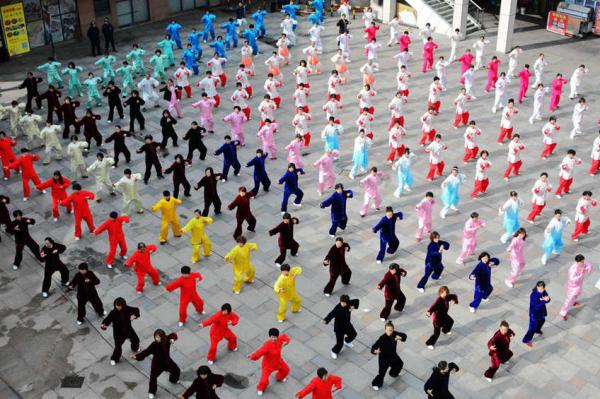Chinese Qigong
What is Qigong
An old school of kung fu in China, Qigong is an ancient Chinese health care system that integrates physical postures, breathing techniques and focused intention. The history of Chinese Qigong commences beyond the era of written records, in the mists of prehistory. Earliest estimates suggest that self enhancement and empowerment practices date into the time of Chinese shamans, previous to 500 BC.
The word Qigong in Chinese is literally combined by two words, Qi and Gong. Qi is vitality, energy, or life force, while Gong means to practice, cultivate, refine. These two words combined together, Qigong, means cultivating energy to health maintenance, healing and increasing vitality. Qigong is not a panacea, but it is certainly a highly effective health care practice.
Functions of Qigong
The Chinese believe that the primary mechanism that is triggered by the practice of Qigong is a spontaneous balancing and enhancing of the natural healing resources in the human system. The slow gentle movements of most Qigong forms can be easily adapted, even for the physically challenged and can be practiced by all age groups. It can be performed virtually anywhere at any time, requiring nothing more than a pair of willing hands. Over thousands of years millions of people have benefited from persistent and disciplined practices, believing that it can maintain health, heal their bodies, calm their minds, and reconnect with their spirit.
Avoiding Disease
Qigong offers individuals a way to achieve a relaxed, harmonious state of dynamic equilibrium. It typically smoothes the process of delivering oxygen to the cells, reduces stress and improve bowel functioning. It is a proper therapeutic practice with which to address virtually many chronic health problems in digestive, respiratory, cardiovascular and nervous systems. Qigong increases strength, improves resistance to infectious diseases and premature senility, and helps assure a long and healthy life. Practicing qigong can greatly reduce the danger of stroke. It may speed recovery from surgery and from sports and other injuries by up to 50%.

Mental Relieve
The gentle, rhythmic movements of Qigong reduce stress, build stamina, increase vitality, and enhance the immune system. Those who maintain a consistent practice of Qigong find that it helps one regain a youthful vitality. One of the more important long-term effects is that Qigong reestablishes the body/mind/soul connection. When these three aspects of our being are integrated, it encourages a positive outlook on life and helps eliminate harmful attitudes and behaviors. It also creates a balanced life style, which brings greater harmony, stability, and enjoyment.
Categories of Qigong
Qigong is different from general physical exercise, it works to ease, smooth and regulate breathing to store up or accumulate energy in the body. It can be divided into two categories: Internal Qigong, which tends to maintain and promote the practitioner's own health; and External Qigong, by which a Qigong master perform and "beam" his/her Qi at a patient.
The basics of Internal Qigong may be acquired through several sessions, which require regulation of the mind, body and respiration. The basic requirement for practicing Qigong is to stay comfortable and relaxed. While mastering the External Qigong requires years of persistent practice. Some qigong masters in China perform External Qigong for patients with acute and serious illnesses like heart disease, cancer, and severe pain.
Qigong may also be classified into Soft Qigong, which stresses health, and Hard Qigong, which is used in kung fu and strength training programs.
'Hard' refers to techniques or forces that are generally dynamic, straight and visibly powerful, is practiced to cultivate great strength, serious stamina, and almost super-human abilities (supposedly); 'soft' to those that are generally graceful and circular, with hidden power, is more of a meditative type, mostly breathing exercises and fairly simple nonstressful movements.
Methods of Qigong
There are over 3,000 methods of Qigong being practiced today, many of which are adaptations of ancient practices. The following are some of the most practiced ones:
Wild Goose (or "Dayan") Qigong
The most commonly practiced in China. It contains 64 movements emulating the movements of the wild goose, the "bird of longevity". It is designed to re-energize the body and is thought to date back to 1,800 years ago in a Taoist monastery in Kunlun, western China.
Five Animal Frolics
Derived from the movements of five animals, the crane, bear, monkey, tiger and deer. Each animal form has a specific movement and breathing pattern. Hua Tuo, the guru of Chinese medicine, is thought to have developed this form.
One Finger/Magic Palm
One finger and Magic Palm are advanced Qigong practices which teach the student to beam his Qi at others from the palms and fingers of his hands. This method can only be learned through the guidance of an experienced and reputable qigong teacher. Improper practice can be harmful.
There are still many other methods of practicing Qigong, all of which require three things in common: physical posture, breathing techniques, and mental focus. Today, there are more than 70 million Chinese practicing qigong, some for treatment and most as a physical exercise. On any morning in the parks throughout China you will find people doing Qigong practices. Qigong lets people experiencing higher levels of energy and stamina, and slow down the aging process. Now qigong is rapidly making an appearance in North America. North American psychological, physiological and medical researchers are studying qigong with rapidly increasing interest. University students throughout North America have formed qigong practice groups. It is natural that such an ancient Chinese care system is becoming more and more popular with such beneficial functions.